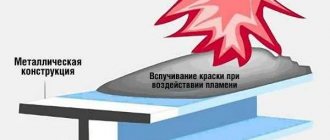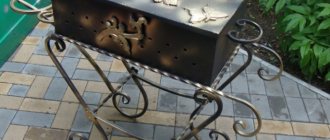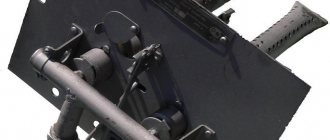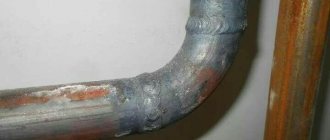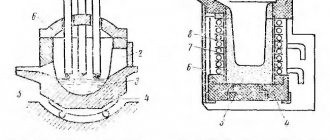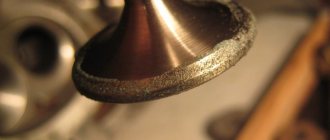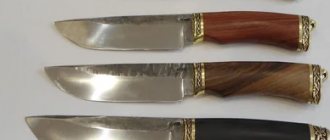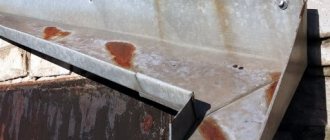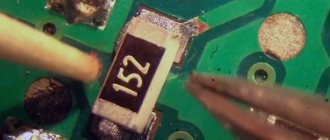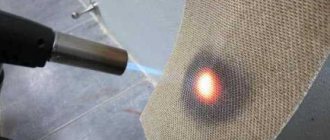Among the means for protecting surfaces heated to high temperatures, varnishes and heat-resistant paints for stoves and fireplaces can be distinguished. Their main feature is that they can cover not only metal, but also brick and concrete.
In order for you to find the best composition for treating a brick stove in your country house or in your own home, we have collected information about the top ten that are in demand on the market. The popularity of the product is justified by practical application and the solid reputation of the manufacturer. Taking into account our recommendations, the choice of product will be simple and clear.
Choosing paint for the stove
The operating temperature for standard metal paint does not exceed 40-50 ℃, so you cannot paint surfaces that are too hot - it will bubble up, lose its original color and may begin to smoke and smell unpleasant. Therefore, in this case, you need to use only special heat-resistant paint for stoves.
Which of the proposed paint options to choose will depend on the area of its application. Thus, a metal sauna stove can heat up to 600-800 ℃ or more - at the epicenter of combustion the temperature is even higher. But its outer walls may not heat up so much - it all depends on the design. Therefore, you need to know how to properly install a stove in a bathhouse. If we are talking about a brick oven, then its surface does not warm up above 200 ℃.
Please note that heat-resistant paint must be suitable for interior use. And for sauna stoves you need paint with moisture protection.
Do I need to paint or is there an alternative?
It is recommended to paint the metal before laying the heat-resistant brick screen and cover the inside of the tank. Instead of painting, bluing is used (details below) or other methods are used:
- Eco-friendly surface treatment with silver is quite effective;
- A budget option is red lead, used in metallurgy;
- A heat-resistant mixture of lime and cement provides good protection against oxidation.
It is recommended to paint the metal before laying the heat-resistant brick screen and cover the inside of the tank.
A little about the types of heat-resistant paints
Painting very hot surfaces of metal furnaces can only be done with heat-resistant, heat-resistant and fire-resistant paints. But fire retardants are not suitable in this case - they are used for other purposes. When heated to 200 ℃, fire-retardant paint swells and blocks the access of oxygen to the structure, protecting it from destruction in fire. Let's take a closer look at the types of paints.
So, heat-resistant paint for stoves is used at a temperature threshold of 600 ℃. Such compositions are suitable for painting metal elements of stoves and fireplaces, as well as for metal heating appliances. But for sauna stoves they use several different types of materials - heat-resistant enamel, which is designed to heat the surface to 800-1000 ℃.
Fireproof paint for metal products can withstand exposure to open flames. Therefore, its temperature threshold is even higher. However, due to the very high cost, it is not advisable to use such compositions at home.
Another type of paint is high-temperature. Their area of application is painting heating batteries and a number of engine components. As a rule, such compositions are operated under heating conditions no higher than 200 ℃. High-temperature paint for brick stoves can only be used if it is necessary to tint the surface or paint the seams. Metal stoves cannot be painted with it.
For brick stoves, you can also use heat-resistant varnish. Its operating temperature is 250-300℃. After treating the surface with this varnish, it becomes shiny and brighter.
Application area
Most often, painting walls with ceramic compositions is practiced in rooms subject to heavy pollution. The paints are ideal for corridors, halls, kitchens, hallways, as well as staircases and landings. Thanks to their moisture resistance, they will become reliable protection for the walls in the bathroom.
No less often, ceramic coatings are introduced into the interior of the living room, nursery, and bedroom. They are used to decorate cafes, restaurants, offices, hotels, kindergartens, and public places. In fact, ceramic paint can be called a universal material suitable for all types of premises. The paint exhibits a high degree of adhesion with the following types of substrates:
- drywall;
- gypsum;
- cement;
- brick;
- concrete;
- tree;
- Fiberboard, MDF;
- plastic and fiberglass;
- glass.
How to choose the right one
To choose the right paint for the stove, you need to carefully consider the label, which says what surface it can be used for, for example, heat-resistant paint for metal products. Often this information is printed in large font and is difficult to miss. In cases where the scope of application of paint and varnish products is wide, this is also written on the packaging, but in small print. Be that as it may, such information must be indicated on the packaging, as well as the name of the manufacturer. If this data is not available, there is no need to purchase such a product. It is possible that this is a counterfeit product that may pose a threat to your health.
For metal sauna stoves, use only moisture-resistant compounds, otherwise they will not last long on the surface.
Material properties
After applying and drying ceramic paint, a unique coating is created on the surfaces, resistant to stains, practically not contaminated and not afraid of water. Even substances such as fruit and berry juices, red wine, tea and coffee can be easily removed from it, and after washing there will not be the slightest stain left.
Wall painted with ceramic paint in the kitchen
Ceramic paint is highly elastic. During operation, the paint film does not crack or peel off due to shrinkage and vibration. The material is able to hide roughness and small defects in the base. It is also characterized by the following properties:
- high degree of vapor permeability;
- excellent adhesion to various building substrates;
- strength, hardness of the coating;
- immunity to mechanical damage and environmental factors.
Packaging
You can purchase heat-resistant paints in various packaging - these can be spray cans or jars. From cans, paint is simply sprayed over the surface, and from a can, paint is used with brushes, rollers or special sprayers.
The volume of the cylinder is usually 500 ml. Cans are produced in 400 g, 800 g, 2.5 kg and 5 kg. There are also large buckets of 5-15 kg and barrels.
Exactly how to apply thermal paint is everyone’s personal choice. For some, it will be more convenient to use a brush or roller, while others will opt for a spray can. In the latter case, the material consumption will be significantly lower, and the paint will apply more evenly and evenly.
Which fireproof paint to choose for the stove
Paint for metal stoves must be selected with a temperature threshold of 600 ℃ or more. Here are a few of the most famous brands with a brief description of each.
Heat-resistant enamel of the CERTA brand, produced by the domestic manufacturer Spectrum. It is designed for use in the temperature range of 65-900 ℃, and its application can be carried out even in frosty temperatures of -30 ℃. The consumer is offered a total of 26 shades of paint, including turquoise, blue and yellow. True, not all colors withstand equally high temperatures. Thus, the most heat-resistant color is black (up to 900 ℃). Behind it are white, gold, brown, copper, red-brown, green, blue, cyan and turquoise (all of them can withstand up to 750 ℃). All other shades can be used at temperatures not exceeding 400-500 ℃. This paint is produced in cylinders, cans and buckets of various sizes.
Termal paint from the Finnish manufacturer Tikkurila. It is made on the basis of alkyd resins and is available in black and silver. It is able to withstand the heating of the metal at the stage when it turns red. When using this paint on sauna stoves, it does not crack or peel for about 3 years. Please note that if you heat the painted surface to 230℃, it will dry in 1 hour. This is a prerequisite for its polymerization.
Hansa brand heat-resistant metal stove paint comes in 16 colors and can be used in temperatures up to 800℃ to paint stainless steel. It goes on sale in barrels, cans and cans.
Heat-resistant paint of the Kudo brand, produced in Russia, is a silicone enamel for metal products. It is designed to heat the surface up to 600 ℃ and is available in 20 shades, including white, black, red and silver. Sold in 520 ml bottles.
Aerosol paint Bosny. Available in two versions - for heating up to 650 ℃ and up to 200 ℃. It fits well, does not change color for a long time and does not crack. This brand of thermal paint is used for painting metal, plastic, ceramics and glass, wood and fabrics. Pay attention to this brand, since glass paint is rare to find. The container capacity is 400 ml.
Hammerite brand heat-resistant metal paint has one feature. It can even be applied over rust without first cleaning the surface. However, beware of its contact with diesel fuel, gasoline and grease. The paint can withstand heating up to 600 ℃ and is available in 250 ml cans. It is applied with a brush.
Anti-corrosion heat-resistant ELCON enamel can withstand temperatures up to 800 ℃, including sudden changes. Used for painting concrete, brick and metal. Available in cans in a large number of colors. There is also an aerosol version of ELCON paint in 520 ml cans - it is designed to heat up to 700 ℃.
Paint for metal and other surfaces KO-8111 “Termika” can withstand up to 600 ℃. In addition, it has a protective effect against stray currents, salts, chlorine, solutions, oils and aggressive substances. Used for painting fireplaces and stoves. In baths, it is better to use the KO-8101 brand and KO-8104 primer from the same manufacturer. In addition to heat resistance, this paint is also moisture resistant.
Rust-Oleum heat-resistant paint is designed for very high heat - up to 1093 ℃. In addition, it protects against gasoline and oils. Release form: aerosol can. It comes in matte white, gray, black and transparent.
All of the above options are successfully used for painting brick and metal heating stoves and boilers. And some are also suitable for sauna stoves.
Obtaining colors by applying soluble salts
Nitric acid salts are best suited, but chloride or sulphate salts are also suitable. To thicken, glycerin, tannin or other tanning agents are added. Mixtures of soluble salts in an aqueous or glycerin solution are applied to a porous shard.
When fired, the metal salt solution decomposes. The oxides deposited in the shard combine with silica, alumina and other components of the shard, forming a beautiful play of colors with the glaze. Sharp-fire paints (Scharl-teuerfarben), obtained by burning for porcelain, are common. They are applied to a fired glazed shard and fired at the firing temperature of the glaze, due to which they penetrate into the softening glaze and produce soft, delicate tones.
In this case, the paint is applied with turpentine condensed oil, as with muffle paints. Almost only cobalt blue is used as paint. It is mixed with feldspar, with glaze or with a small amount of boric acid. These paints are fired in an oxidizing flame.
Preparing the surface for painting
Before painting a metal stove, it is important to properly prepare the surface. In some cases, no prior preparation is required, but in others, you must follow the instructions on the label.
Typically, preparation includes:
- Cleaning the surface from traces of oils and grease, old coating, water-soluble salts and other things.
- Removing rust down to gray metal using sandpaper, a grinder or drill attachment, or a sandblaster. Sometimes the surface can be coated with rust converters, but this must be indicated on the paint package. Upon completion of treatment, the surface must be washed and dried. Rust must be removed completely, down to the smallest specks.
- Degreasing the surface with xylene or solvent immediately before painting. Further coloring should be carried out no later than 6 hours after treatment outdoors or 24 hours indoors.
In each case, the required number of paint layers and their direction are purely individual. If more than one layer is required, they are applied in different directions so that the paint goes on more evenly.
The temperature and drying conditions of the paint, as well as the gap between application of layers, are always indicated on the label. Following the manufacturer's recommendations will allow you to obtain a coating that will last the specified period.
Choosing paint for a brick stove in a bathhouse
The outer surface of a brick sauna stove does not heat up too much, as a rule, no higher than 70-80℃. Near the cast elements, a brick sauna stove may heat up a little more, but in any case not higher than 200 ℃.
In this case, the following brands of paint are suitable:
- Ecoterra heat-resistant paint is designed to heat up to 400 ℃ and is used on concrete and ceramic surfaces. The paint is matte, red-brown.
- A brick sauna stove can be painted with anti-corrosion heat-resistant ELCON enamel. It can heat up to 700℃. The same company also produces heat-resistant varnish of the KO-85 brand, which is intended for surfaces with a temperature of no more than 250 ℃. It is successfully used for decorative finishing of the surface of a brick oven.
- Heat-resistant paint Certa is also suitable for painting sauna brick stoves.
- Bosny heat-resistant aerosol is ideal for glass and ceramic surfaces, including brick.
- KO-8101 paint is equally applicable for both metal and brick stoves.
It is worth noting that in addition to painting, there are a number of other ways to decorate a brick oven externally. To refine the brickwork, it can be plastered and whitewashed with chalk or lime. If, after plastering, the surface is puttied and covered with water-based emulsion, it will be more beautiful and will not stain clothes. The unpleasant odor of the water-based emulsion will completely disappear after drying completely and reappear. In addition, it allows you to tint the stove in any shade or apply any decorative painting in the future.
For metal elements, paint must be selected with a heating temperature of up to 800 ℃ or more, that is, the same as for a metal furnace. Before painting, parts must be cleaned of dirt, rust and old paint. Painting tape is placed on top of the brick around the steel elements and you are ready to go. Please note that when working with aerosols, the spray surface will be larger, so the area of protected areas must be increased so as not to subsequently repaint the oven itself.
Functions of the paint and varnish coating of a brick heater
Painting a stone heating device is carried out for the following purposes:
- protection of the stove surface from absorbed contaminants, and clothing from brick dust upon contact with brickwork;
- facilitating daily care, that is, maintaining the necessary sanitary and aesthetic condition;
- increasing the decorative design class of the unit;
- adapting the design of the heating device to the existing interior.
Brick heaters coated with colorless heat-resistant varnish
*
If the bricklaying was done without sorting the stone by color, then painting the body with a heat-resistant paintwork material (paint and varnish material) of one or more colors will correct the situation. But even a stove finished with face brick is transformed after applying, for example, a colorless paint coating, which gives a richness and matte hue to the stonework.
